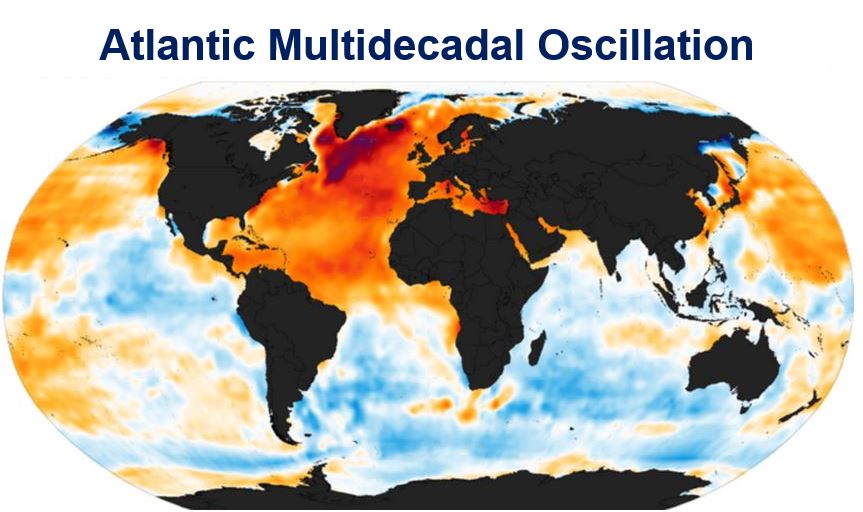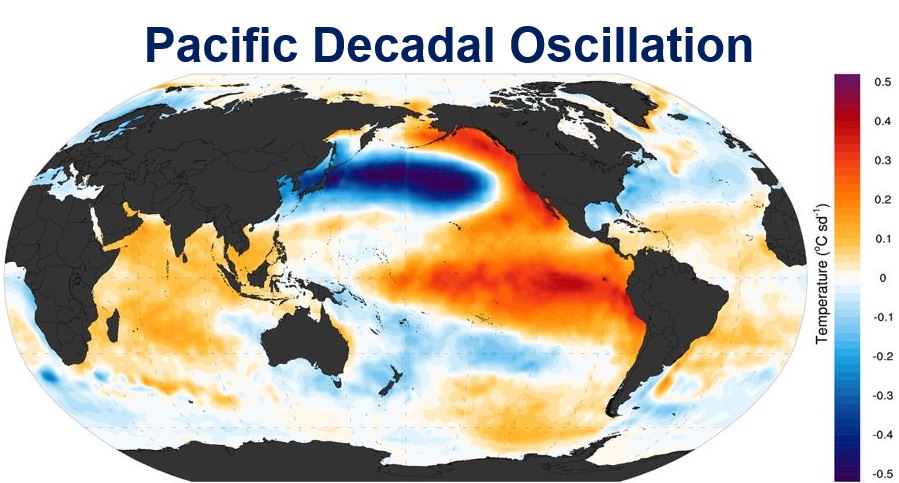The Pacific Ocean is coming to the end of its cooler period, which gave global warming a “false pause” of more than a decade, scientists warn. When it warms up again, climate warming, which they believe is caused by human activity, will accelerate.
Distinguished Professor of Meteorology at Penn State, Michael Mann, and team explained that the recent halt in global warming has been partly due to the natural fluctuations in the climate, with the pendulum soon going the other way.
These swings represent “variability to the internal climate system,” and in no way suggest that human-induced global warming has stopped. The recent slowdown, such as it was, is certainly no reason not to worry, they stress.

AMO spacial pattern. (Credit: Giorgiop2, Own work, via Wikipedia. Image Source: Penn State)
“We know that it is important to distinguish between human-caused and natural climate variability so we can assess the impact of human-caused climate change on a variety of phenomena including drought and weather extremes.”
“The North Atlantic and North Pacific oceans appear to be drivers of substantial natural, internal climate variability on timescales of decades.”
University of Minnesota-Duluth researcher Sonya K. Miller, Byron A Steinman, assistant professor of geological sciences at Penn State, and Prof. Mann studied a combination of real-world observational data and model simulations to determine what factors have contributed to climate variability in the Northern Hemisphere.
They wrote about their findings in the academic journal Science.
AMO, PDO and PMO
The Atlantic Multidecadal Oscillation, or AMO, shows how sea-surface temperatures have fluctuated in the North Atlantic over 50 to 70 years.
The Pacific Decadal Oscillation, or PDO, varies over a much longer timescale, so the researchers only looked at the multidecadal portion of it (Pacific Multidecadal Oscillation or PMO).
After running a number of climate simulations, the scientists found that AMO and PMO are not closely correlated, i.e. they are not, as some experts had claimed, part of the global “stadium wave” oscillation.

PDO spcial pattern during the “warm phase”. (Image: Wikipedia)
Pacific Ocean has slowed Northern Hemisphere warming
Warming in the Northern Hemisphere has recently slowed down considerably, they found, because of a steeply down-trending PMO. Given that AMO was comparatively flat, they could tell the climate warming slowdown had nothing to do with Atlantic Ocean temperatures.
In other words, a cooler Pacific Ocean has been giving global warming a “false pause”.
They concluded that the cooling of the Pacific Ocean and the unusual slowdown in climate warming over the past decade are linked to heat buried beneath the tropical Pacific and a tendency for prolonged La Niña type conditions.
The scientists wrote:
“While there is paleoclimate data suggesting that this type of response could come from subtle features of climate change itself that climate models do not currently capture, the researchers note that the most likely explanation is the random excursions of the AMO.”
Prof. Mann explained:
“Our findings have strong implications for the attribution of recent climate changes. Internal multidecadal variability in Northern Hemisphere temperatures likely offset anthropogenic warming over the past decade.”
The Pacific Ocean’s cooler period will soon be over, the researchers predict. When it warms up again, global warming will continue apace.
Citation: Byron A. Steinman, Michael E. Mann & Sonya K. Miller. “Atlantic and Pacific multidecadal oscillations and Northern Hemisphere temperatures.” Science. 27 February, 2015. DOI:10.1126/science.1257856.
